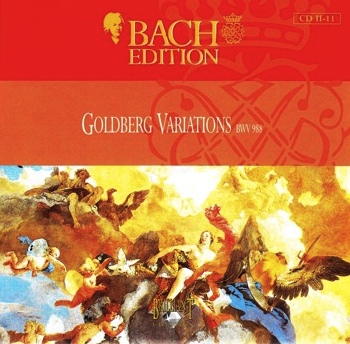 If you’re expecting me to get through today’s listening without mentioning Glenn Gould, you’re going to be sorely disappointed.
If you’re expecting me to get through today’s listening without mentioning Glenn Gould, you’re going to be sorely disappointed.
For today’s Brilliant Classics CD (performed by Pieter-Jan Belder on Flemish harpsichord) is none other than the famous Goldberg Variations, which was Glenn Gould’s first album, recorded in 1955 for Columbia Records.
But that’s another story.
Today’s story begins with the question, “Who was Goldberg?”
For the answer, I’ll turn again to Wikipedia, which — in the very first paragraph — tells me this:
The Goldberg Variations, BWV 988, is a work for harpsichord by Johann Sebastian Bach, consisting of an aria and a set of 30 variations. First published in 1741, the work is considered to be one of the most important examples of variation form. The Variations are named after Johann Gottlieb Goldberg, who may have been the first performer.
So Johann Gottlieb Goldberg may have been the “first performer.” The first performer of these variations? Or the literal first performer ever on the harpsichord?
For the answer, I’ll turn to the page on Wiki on Mr. Goldberg, which tells me this:
Johann Gottlieb Goldberg (also Gollberg, Goltberg; baptised 14 March 1727 – 13 April 1756) was a German virtuoso harpsichordist, organist, and composer of the late Baroque and early Classical period. He is most famous for lending his name, as the probable original performer, to the renowned Goldberg Variations of J.S.
…He was probably of German ancestry, and was born in Gdansk (Danzig) in Poland. Little is known for certain about his childhood, other than that he was an exceptionally talented performer, attracting the attention of Hermann Karl von Keyserlingk, the Russian ambassador to Saxony, around 1737. Goldberg was reported to have studied with both J.S. Bach and Wilhelm Friedmann Bach, J.S. Bach’s eldest son, though the periods of study are not known; Goldberg may have studied with J.S. Bach as early as 1737, shortly after Keyserlingk recognized his talent in Danzig, and Goldberg may have studied with W.F. Bach at any time before 1745, since W.F. Bach was in Dresden throughout Keyserlingk’s tenure there as ambassador.
The most famous part of Goldberg’s life is the portion, probably in 1741, recounted by J.S. Bach’s biographer Johann Nikolaus Forkel, which involved the composition of a set of variations by Bach as a soporific to help the insomniac Count Keyserlingk fall asleep. Keyserlingk’s favorite chamber harpsichordist was the 14-year-old Goldberg, whose technical accomplishments were so spectacular that they made it possible for him to perform a work of such extraordinary difficulty. Whether the Count actually slept through performances of the piece is not recorded, but he did indicate that Bach’s composition was a great favorite of his.
So, there it is.
As for the music itself, the famed “variations,” I can tell you that these are fascinating, engrossing, compelling — and yet, somehow, strangely emotionally detached from me as the listener. I think it’s the harpsichord. Like the fuzz-wah sound of a 1960s guitar (or “White Rabbit” from Jefferson Airplane or “Fortunate Son” from CCR), the harpsichord is locked into a specific era of time. I can’t extract the instrument from its period. So I can’t feel the music as well as I would like.
Here are the compositions on today’s CD:
BWV 988 — 1741 (Bach was 56)
For a real treat, here’s the complete Goldberg Variations performance by Glenn Gould — the entire 47 minute performance. You can thank me later.

 You can call me Johann. But don't expect me to answer to that.
You can call me Johann. But don't expect me to answer to that.
No Comments so far ↓
There are no comments yet...Kick things off by filling out the form below.